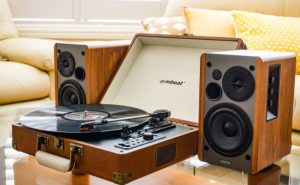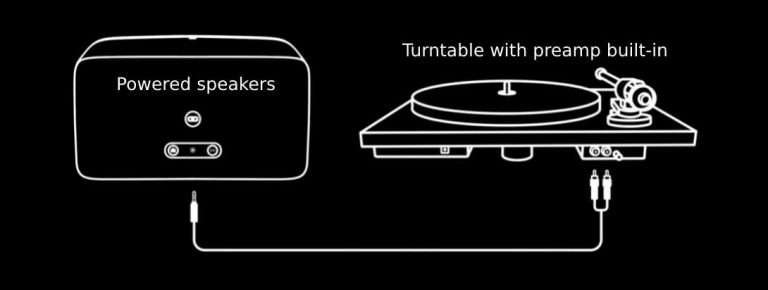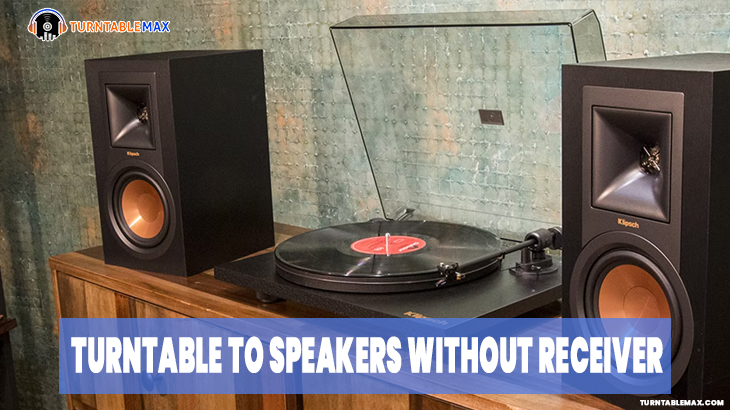Is it possible to connect turntable to speaker without receiver? Well, yes, you can. The receiver act as an amplifier that generally helps to get better sound quality. The advantage of using receivers is it allows you to switch between various audio inputs like CD, AUX, TV, and much more. It is because of this reason many people use a receiver.

Most modern HiFi systems use receivers, but it doesn’t mean you need it to connect turntable and speakers. For a turntable, it’s just an additional component that generally makes the setup bulkier and heavier.
However, if you want to keep your turntable setup simple and compact, ditching the receiver would make sense. In this article, we will explain the possible ways to connect turntable to speaker without receiver. Let’s dive in.
RECOMMENDED ACTIVE SPEAKERS FOR YOUR TURNTABLE
BASIC COMPONENTS REQUIRED FOR THE SETUP
Before proceeding with the connections, you need to know the basic requirements and their purpose. There are four main components you will require they are,
- Turntable
- Preamp
- Amplifier
- Speakers
1) TURNTABLE
There are various types of turntables available on the market. But the main thing you need to consider while getting a turntable is what type of output signal the turntable offers.
Some turntables produce PHONO output signals.
Some turntables produce LINE audio signals.
The thing is, if your turntable has phono output, then you will need a PHONO preamp. On the contrary, if the turntable produces LINE output, then it already has an inbuilt phono preamp.
This represents that turntables come with and without inbuilt preamps. On the other hand, if the turntable has an inbuilt preamp, you are good to go. You can connect the turntable directly to an amplifier or powered speakers.
But if the turntable doesn’t have an inbuilt preamp, you need to get a standalone preamp or a speaker with an inbuilt amplifier.
2) PREAMP
Without going into too complex technical details, turntables require special treatment on the hi-fi system by their operation and technology. At the back of your chain or your amplifier, you will find stereo audio inputs in red and white, and these are called RCA line inputs.
Perfectly suited to the signal from a CD player, FM tuner, or audio DAC, they are not suitable for a vinyl turntable. Sound from a turntable requires special processing ( called RIAA correction ) and amplification. If you connect your turntable directly to this RCA input, the sound level will be very low, and the distortion (degraded signal) will make the sound unusable. To connect a turntable, you need a dedicated RCA input, called a phono input.
- If your turntable has an integrated phono preamplifier, then it can be connected directly to powered speakers.
- If your turntable doesn’t have an inbuilt preamp, you need to get a separate phono preamplifier.
The turntable with preamp is often equipped with a switch that allows you to switch from a phono output to line output. First, check that the switch is on “Line.” The inputs on your active speakers can be Cinch (RCA), Jack, or XLR. Then take a suitable RCA cable to the type of connection of your listening.
If the turntable of your choice does not have a built-in preamp, you will need to get one. The preamplifier will act as an interface between your turntable and your active speakers.
3) AMPLIFIERS
An audio amplifier is an electronic element that will amplify, that is to say, increase the intensity of an audio signal to transmit it to a speaker and generate a sound (music, for example). The amplifier is necessary for a speaker to provide it with power and sound quality.
It is the central element of an audio installation. It will circulate the sound from a source (for example, a smartphone) to the speakers. To put it simply, you will need an amplifier to get the sound enclosure.
4) SPEAKERS
After understanding the role of the amplifier for a speaker, let us approach the active speaker and passive speakers.
- ACTIVE SPEAKERS:
The active speaker integrates an amplifier and a speaker directly in the same device. There is, therefore, no need for an additional audio amplifier to operate it.
- PASSIVE SPEAKERS:
A passive speaker, unlike an active one, does not have an amplifier. You will therefore need to obtain an amplifier corresponding in particular to the power characteristics of your speaker.
So if you want to connect your turntable to speakers without a receiver, make sure that you have active or powered speakers.
HOW TO CONNECT THE TURNTABLE TO THE SPEAKERS WITHOUT A RECEIVER
Here are the possible ways to connect the turntable to speakers without a receiver
#1 CONNECTING TURNTABLE WITH INBUILT PREAMP TO THE POWERED SPEAKER

This is one of the easiest and most compact turntable setups. For this, you will need a turntable integrated with a preamp, powered speakers, and RCA cables.
Connect one end of the RCA cables to the turntable’s phono output and the other end to the powered speaker’s input port. Since powered speakers have amplifiers and other components integrated, they will perfect compact space.
#2 CONNECTING TURNTABLE WITH AN EXTERNAL PREAMP TO POWERED SPEAKER

This setup is similar to the first one, but it adds a separate standalone phono preamp into the setup. Using a separate preamp offers you the flexibility to achieve a customized sound and eliminate components from your turntable by using it separately to get a more precise signal output.
The connection is quite simple, and you will need two sets of RCA cables. First, connect the Turntable output to the input port of the Phono preamp with RCA Cable. Now connect the output of the phono preamp to the powered speaker.
Since we are using a separate preamp, you need to connect the ground port of the turntable, preamp, and powered speakers to avoid any noise distortion or buzzing, or humming noise.
#3 USE BLUETOOTH SPEAKERS
It is possible to connect your turntable to a Bluetooth speaker. For this, you will need a turntable with a Bluetooth connectivity feature and Bluetooth speaker. If your turntable doesn’t have a Bluetooth feature, then you will need a Bluetooth adaptor. The purpose of the Bluetooth adapter is to convert your regular turntable into a Bluetooth turntable.
So you can connect your turntable with a wireless speaker using a Bluetooth transmitter and a Bluetooth adapter. Though this is a good way to use this setup, we do not suggest this. Wireless transmission may not be able to maintain and deliver the high-quality audio standards of vinyl records.
CONCLUSION
If you are an audiophile who wants a simpler setup, then removing the receiver can be overkill. However, it also makes your HiFi system more portable.
Another benefit of ditching the receiver is saving money. Suppose you are a beginner who is new to the turntable, and you have a limited budget. In that case, I recommend you to spend more on the turntable’s quality and on the vinyl collection, rather than spending it on a receiver.
More specifically, the receiver isn’t everything if you want to grow your record collection or if you wish to keep your turntable system as minimalist as possible.


